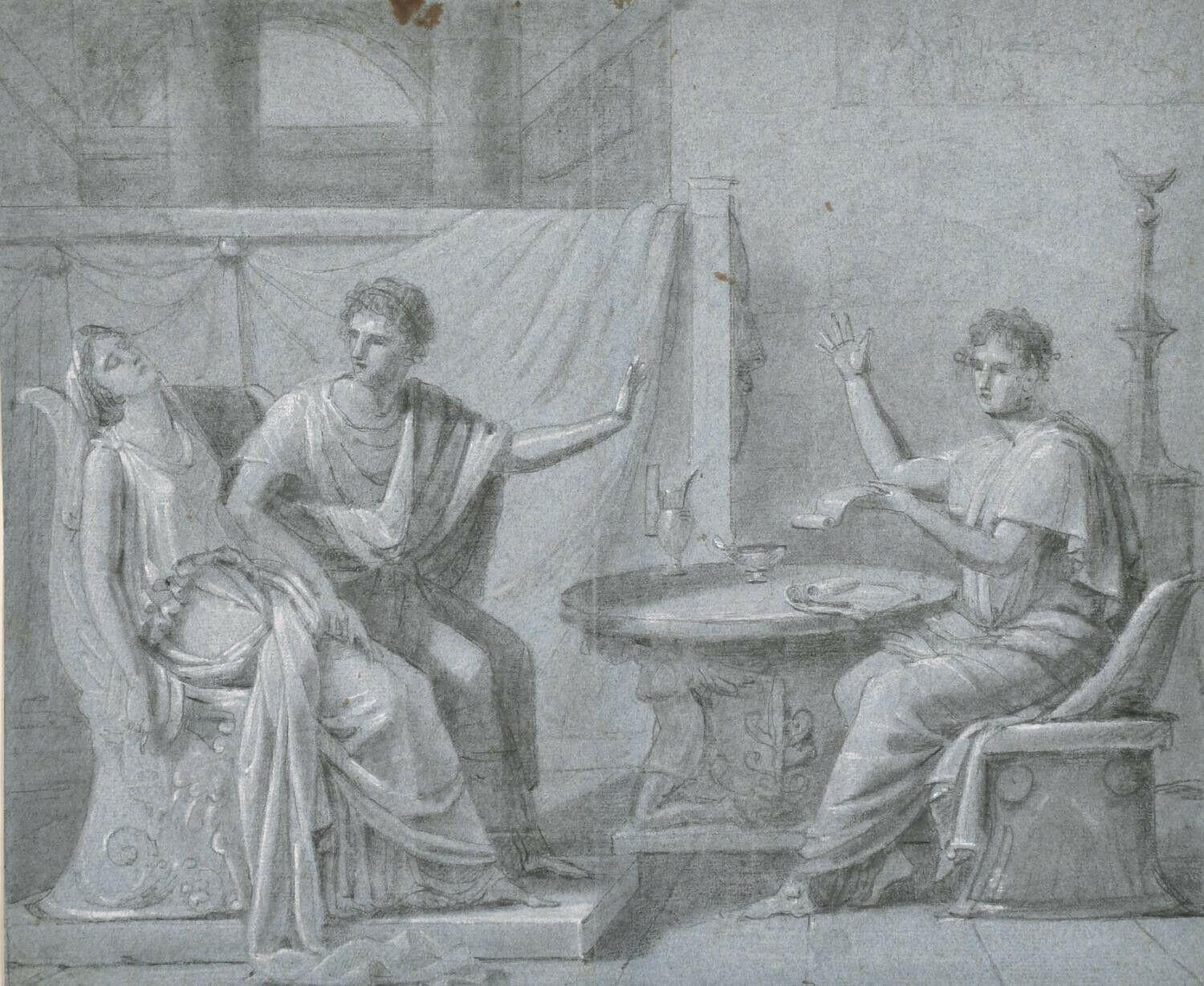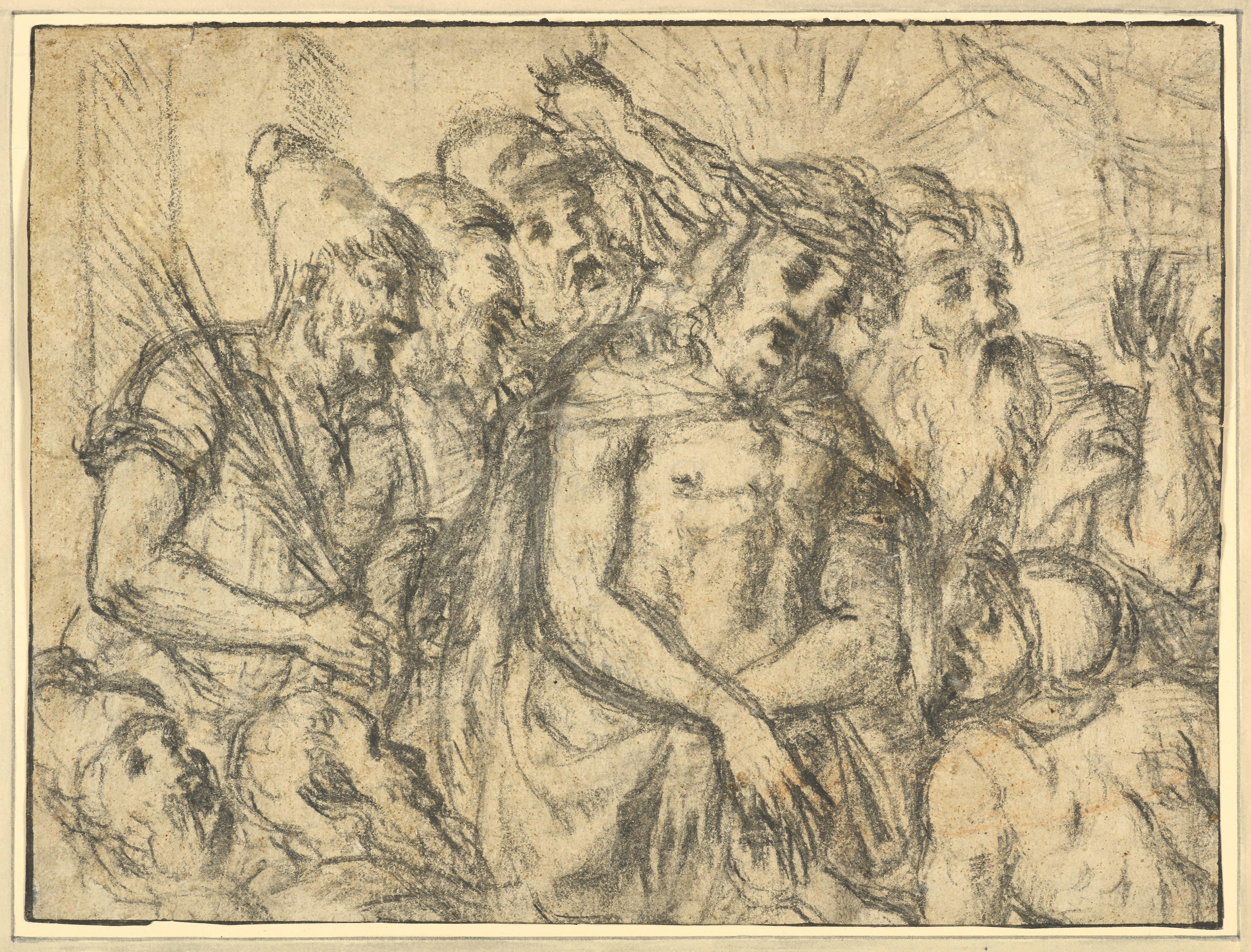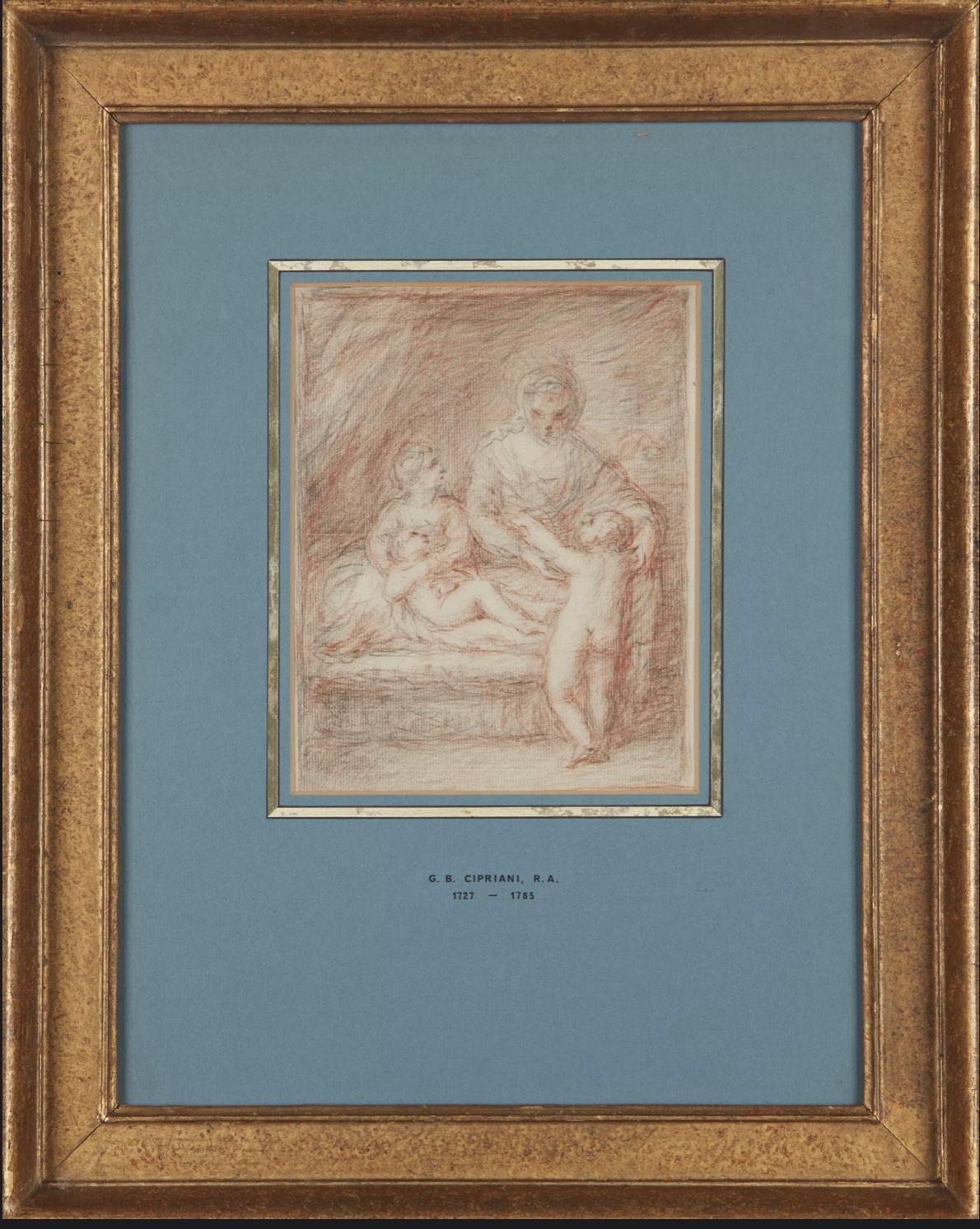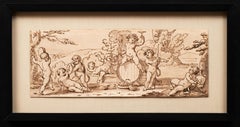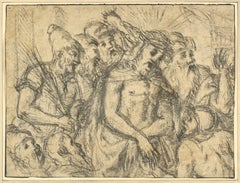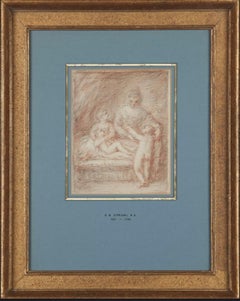
Old Masters Sanguine Drawing of Putti and a Lion, 18th century
View Similar Items
Want more images or videos?
Request additional images or videos from the seller
1 of 4
UnknownOld Masters Sanguine Drawing of Putti and a Lion, 18th centuryCirca 1700
Circa 1700
About the Item
- Creation Year:Circa 1700
- Dimensions:Height: 7.13 in (18.12 cm)Width: 8.63 in (21.93 cm)Depth: 1.5 in (3.81 cm)
- Medium:
- Movement & Style:
- Period:
- Condition:The condition is very good. The innermost frame is period and probably original to the piece with the addition of a later frame added for style.
- Gallery Location:SANTA FE, NM
- Reference Number:1stDibs: LU1408210693672
About the Seller
5.0
Platinum Seller
These expertly vetted sellers are 1stDibs' most experienced sellers and are rated highest by our customers.
Established in 1995
1stDibs seller since 2020
89 sales on 1stDibs
Typical response time: 1 hour
More From This SellerView All
- Antique Italian School Late 17th - Early 18th "Cherubs (A)" Pen drawing of PuttiLocated in SANTA FE, NM"Cherubs" (A) Pen and Ink drawing of Putto Italian School Late 17th early 18th century. Pen and ink on paper 6 ½ x 17 ½ (22 ½ x 11 ½) inches Antique scenes of putto and a faun cele...Category
Late 17th Century Old Masters Figurative Paintings
MaterialsPaper, Ink, Pen
- Antique Italian School Late 17th - Early 18th "Cherubs (B)" Pen drawing of PuttiLocated in SANTA FE, NM"Cherubs" (B) Pen and Ink drawing of Putto Italian School Late 17th early 18th century. Pen and ink on paper 6 ½ x 17 ½ (22 ½ x 11 ½) inches Antique scenes of putto and a faun cele...Category
Late 17th Century Old Masters Figurative Paintings
MaterialsInk, Paper, Pen
- Large Antique 19th Century Dog Painting of a Poodle Inscribed "Zoraida"Located in SANTA FE, NMThe name Zoraida in Arabic means "captivating woman" Large Antique 19th Century Dog Painting of a Poodle Inscribed "Zoraida" Oil on canvas, original frame 37 x 29.5 inches This is...Category
19th Century Old Masters Animal Paintings
MaterialsOil, Canvas
- 18th Century European Portrait of a Child Saint John the BaptistLocated in SANTA FE, NM18th Century European Portrait of a Child Saint John the Baptist Oil on Canvas 19 x 14 1/4 inches This lovely and sensitively painting has been examined by a professional restorer w...Category
18th Century Old Masters Figurative Paintings
MaterialsOil, Canvas
$12,375 Sale Price44% Off - Antique Horse "Heads, Hooves, Rump 1838" Wouterus Verschuur (Dutch, 1812-1874)Located in SANTA FE, NMAntique Horse Study "Heads, Hooves and Rump, 1838" Wouterus Verschuur (Dutch, 1812-1874) Pencil on paper Signed and Dated "W Verschuuur 1838" 10 x 6 1/2 (17 1/2 x 14 frame) inches In his time Wouterus Verschuur was an acclaimed and celebrated painter of horses. Through careful observation he learned to capture their physique and movement to perfection. As a true-born romanticist he was also interested in their character, thereby painting powerful carthorses in their stable, thoroughbred saddled horses during an afternoon ride or harnessed horses in action. He was born to an Amsterdam jeweler and received his training from the landscape and cattle painters Pieter Gerardus van Os and Cornelis Steffelaar. As part of this education Verschuur had to copy works by the 17th century painter Philips Wouwerman. Like Wouwerman, Verschuur's subjects consist mostly of stable scenes, landscapes with horses and coastal landscape. These works reflect the enduring influence of the northern Baroque masters on nineteenth century art, revealing the artist's close study of his Dutch and Flemish predecessors harking back to Peter Paul Rubens. Showing talent from a very early age, at 15 Verschuur had a painting exhibited at the "Exhibition of Living Masters" at Amsterdam in 1828. In 1832 and 1833 he won the gold medal at the annual exhibition at Felix Meritis. In 1833 he was appointed a member of the Royal Academy in Amsterdam. In 1839 he joined the artists' society, Arti et Amicitiae. His reputation was also considerable abroad. He was often featured in the annual exhibitions which travelled the large European cities at that time. In 1855 Napoleon III purchased one of his paintings at the Exposition Universelle* in Paris. The Verschuur horse revels in its physicality, like a quintessential Baroque horse...Category
1830s Romantic Animal Drawings and Watercolors
MaterialsPencil, Paper
- Antique Horse Study; Legs and Rumps, 1838" Wouterus Verschuur (Dutch, 1812-1874)Located in SANTA FE, NMAntique Horse Study "Legs and Rumps, 1838" Wouterus Verschuur l (Dutch, 1812-1874) Pencil on paper Signed and Dated "W Verschuur 1838" 10 x 6 1/2 (17 1/2 x 14 frame) inches In his time Wouterus Verschuur was an acclaimed and celebrated painter of horses. Through careful observation he learned to capture their physique and movement to perfection. As a true-born romanticist he was also interested in their character, thereby painting powerful carthorses in their stable, thoroughbred saddled horses during an afternoon ride or harnessed horses in action. He was born to an Amsterdam jeweler and received his training from the landscape and cattle painters Pieter Gerardus van Os and Cornelis Steffelaar. As part of this education Verschuur had to copy works by the 17th century painter Philips Wouwerman. Like Wouwerman, Verschuur's subjects consist mostly of stable scenes, landscapes with horses and coastal landscape. These works reflect the enduring influence of the northern Baroque masters on nineteenth century art, revealing the artist's close study of his Dutch and Flemish predecessors harking back to Peter Paul Rubens. Showing talent from a very early age, at 15 Verschuur had a painting exhibited at the "Exhibition of Living Masters" at Amsterdam in 1828. In 1832 and 1833 he won the gold medal at the annual exhibition at Felix Meritis. In 1833 he was appointed a member of the Royal Academy in Amsterdam. In 1839 he joined the artists' society, Arti et Amicitiae. His reputation was also considerable abroad. He was often featured in the annual exhibitions which travelled the large European cities at that time. In 1855 Napoleon III purchased one of his paintings at the Exposition Universelle in Paris. The Verschuur horse revels in its physicality, like a quintessential Baroque horse...Category
1830s Romantic Animal Drawings and Watercolors
MaterialsPencil, Paper
You May Also Like
- A red chalk study sheet by Baldassare Franceschini, known as VolterranoLocated in PARIS, FRThis fresh sanguine sheet presents various studies placed next to each other in no apparent order. Two of the feet studies are preparatory to the first major commission received by the young Baldassare Franceschini, shortly after his installation in Florence, the frescoes for the Medici Fastes. This cycle was executed between 1636 and 1646 for the Villa La Petraia, a Medici villa on the outskirts of Florence, which allows us to date this sheet to the artist's youth. 1. The Medici Fastes, the first major commission for a young artist Born in Volterra in 1611, the town from which he took his nickname, Baldassare Franceschini apprenticed with his father, a sculptor of alabaster, one of his home town's specialities, and studied with Cosimo Daddi (1540-1630), a local artist. The Marquis Inghirami, who spotted his talent, sent him to the workshop of Matteo Rosselli (1578 - 1650) in Florence, which was also attended by Francesco Furini (1603 - 1646). In 1636, Lorenzo de' Medici, the youngest son of Ferdinand Ier and Christine of Lorraine, chose the 25-year-old artist, again on the advice of the Marquis Inghirami, to decorate with frescoes the loggias of the inner courtyard of the Villa La Petraia, which he had just inherited on the death of his mother. The project lasted about ten years and included ten scenes placed symmetrically in two loggias on either side of the courtyard: four main scenes and six placed above the doors, each to the glory of a member of the Medici family. This decoration was his major secular project, but Volterrano also executed several religious frescoes and a few easel paintings, often with less success. Among the religious commissions, we can cite the dome of the Colloredo chapel dedicated to Saint Lucy...Category
Mid-17th Century Old Masters Figurative Drawings and Watercolors
MaterialsChalk, Paper
- Christ before Herod, a drawing from the School of TitianLocated in PARIS, FRThis vigorous drawing is clearly inspired by the numerous compositions on the Ecce Homo theme which were produced by Titian and his workshop at the painter's maturity. However, the number of characters and their expressionist treatment, the many variations to Titian's paintings reveal a drawing made by an original artist, perhaps of foreign origin, belonging to the peripheral circle of the "Titian solar system”, as described by the art historian Enrico Maria del Pozzolo. 1. Titian, the leading artist of 16th century Venetian painting and his botteghe Tiziano Vecelli (or Vecellio), known as Titian, was born between 1489 and 1490 in Pieve di Cadore in the Veneto region of Italy into a wealthy family of soldiers and lawyers. At the age of 15, he joined the studio of Giovanni Bellini, where he became friend with Giorgione, ten years his senior. Giorgione introduced him to a new pictorial style in which forms are defined by colour and pictorial substance, freeing himself from the meticulous underlying drawings characteristic of Bellini's painting. Titian became the official painter of the Republic of Venice upon Bellini's death in 1516. In 1518, the completion of his Assumption for the church of Santa Maria Gloriosa dei Frari in Venice established his reputation as the leading painter of the Venetian school: throughout his career, Titian had a considerable impact on other artists of his time, whether they were direct collaborators, occasional contributors, or other artists under his influence. Considered one of the greatest portraitists of his time, his fame spread throughout Europe and he became the official painter of the greatest European families: the Gonzagas, the Farneses (Alessandro Farnese, of whom he executed several portraits, was elected pope in 1534 under the name of Paul III), the Habsburgs (he went to Augsburg in 1548 to paint the portrait of Charles V and King Philip II of Spain, his successor, later became the artist's main patron). As Titian almost reached the age of 90 years, he saw during his lifetime the death of many of his loved ones (his wife Cecilia, his brother Francesco and his son Orazio). A pathetic feeling appears in his late artworks, such as his famous Pieta, his last work intended to decorate his tomb which remained unfinished. Titian's success was also based on the establishment of a large and versatile workshop, which, alongside the traditional assistance in the production of certain paintings, ensured the publication of numerous woodcuts, allowing the master's works to be widely distributed. Long ignored by art historians, the individual stories of these various collaborators, the organisation of this workshop and the interactions of the collaborators with the master are at the heart of contemporary studies on the artist. 2. A complex composition with expressionist overtones Executed with great virtuosity in black chalk, the composition of our drawing is complex, even slightly confused and probably reflects several phases of execution, if not several hands. The scene is organised around the characters of Christ and an executioner wearing a Phrygian cap. Christ is presented at mid-body, slightly at an angle, his torso bare, his shoulders draped in a cloak, his hands clasped together and probably bound. His head, as if weighed down by the crown of thorns, is slightly bent forward. The eyes and mouth are hollowed out by the black chalk to better express his sorrow. The man wearing a Phrygian cap holds a whip in his right hand, while his left hand, barely outlined, seems to be pulling aside Christ's tunic as if he were about to scourge him. Two other men, who may have been added at a later stage, occupy the space between the executioner and Christ. One is depicted in profile, while the one behind Christ appears to be wearing a military helmet. In an indistinct gesture, his left arm is raised as if to strike Christ. Slightly behind Jesus on his left side, appears a bearded old man wearing a turban. With his left arm raised, he holds out the palm of his hand in a gesture of amazement. His face is finely executed and contrasts with the hand depicted in a rather crude manner. This character may also have been added at a later stage, as he does not fit in perfectly behind the group formed by Jesus and his executioner. This frieze is completed in the left foreground by two additional figures depicted in three-quarter view. Soberly sketched but with great fluidity, only their heads emerge, as if Christ and his executioners were situated on a pedestal above a large crowd. Finally, on the right-hand side of the composition, a second helmeted soldier is depicted. His musculature can be seen under his armour while he stares intently at Christ. He is smaller than the other figures, even though he appears in the front row, revealing a certain clumsiness on the part of the artist. 3. Ecce Homo, one of Titian’s favourite subjects in his twilight years In 1543, Titian tackled the theme of the Ecce Homo in a masterly composition now in the Kunsthistorisches Museum in Vienna. Christ is presented by Pilate, dressed in an antique costume, at the top of a staircase, in a large, highly architectural setting animated by a crowd of characters. The title of the painting refers to a passage from the Gospel of St John (19, 1-5): “Then Pilate took Jesus and had him flogged. The soldiers twisted together a crown of thorns and put it on his head. They clothed him in a purple robe and went up to him again and again, saying, “Hail, king of the Jews!” And they slapped him in the face. Once more Pilate came out and said to the Jews gathered there, “Look, I am bringing him out to you to let you know that I find no basis for a charge against him.” When Jesus came out wearing the crown of thorns and the purple robe, Pilate said to them, “Here is the man!” From the 1540s onwards, Titian and his workshop repeatedly depicted the Christ of Sorrows for their principal patrons. In these paintings, Titian returned to the half-body format that he had practically abandoned since 1520 and refocused the composition (compared to the large 1543 Ecce Homo) on the figure of Christ, who is depicted alone or accompanied by a few figures. With his eyes lowered and his head slightly bowed, Titian's Christ seems calmly resigned to his fate. Powerless and submissive, he arouses deep pathos from the viewer. The tondo in the Louvre Museum shows Christ in a position very similar to that of our drawing, a position that will be found in most of Titian's Ecce Homo. To his right stands a helmeted soldier who seems to be baring his shoulder and to his left a servant of Pilate wearing a Phrygian cap. These two figures are reminiscent of the soldier in the lower right corner and the executioner in the left most part of our drawing. Various versions were executed by Titian and his workshop until the late 1560s, and the version that seems closest to the right-hand side of our drawing is the one in the Prado Museum. Although of uneven quality, it is interesting to note the gesture of Pilate's hand, holding out the palm of his left hand towards the viewer, as if to distance himself from the decision that the crowd will make. Recent X-rays of the painting have shown that the executioner on the right, depicted from behind, was originally depicted in profile (as in our drawing), and that the other two figures (Pilate on the left of Christ and a servant wearing a Phrygian cap on his right) were added later. The painting was then organised around the diagonal that crosses the canvas from left to right, emphasised by the light coming from the window, and centred on the exchange of glances between Christ and the executioner on his left. The profile of the old man in the foreground on the left could be inspired by that of the elderly Titian as it appears repeatedly in the painter's late artworks, such as the Madonna of Mercy in the Palatine Gallery. 4. A deeply original drawing, at the risk of confusion We saw in the last paragraph the various borrowings from Titian's depictions of the Ecce Homo that can be found in this drawing: the position of Christ, the presence of executioners wearing Phrygian caps and of helmeted soldiers, one of whom is looking at Christ in a position that evokes the repentance visible with X-ray in the Madrid painting...Category
16th Century Old Masters Figurative Drawings and Watercolors
MaterialsChalk
- Fine 18th Century Italian Old Master Drawing Mother & ChildrenLocated in Cirencester, GloucestershireGiovanni Battista Cipriani, RA, Italian 1727-1785 Sketch of a mother with three children; black and red chalk on laid paper with watermark '© TAYLOR', 22.4 x 17.5 cm. Provenanc...Category
18th Century Old Masters Figurative Paintings
MaterialsChalk
- FINE 18th CENTURY OLD MASTER CHALK DRAWING - ROMANESQUE FIGURES INTERIOR SCENELocated in Cirencester, GloucestershireArtist/ School: French School, 18th century Title: Classical figures within an interior. Medium: chalk on paper, mounted. Size: drawing: 11.5 x 13.5 inches Provenance:...Category
Early 18th Century Old Masters Figurative Paintings
MaterialsChalk
- Follower of Francesco Guardi, Figures in a Mediterranean port by a Roman ArchBy Francesco GuardiLocated in Harkstead, GBA lively, well executed sketch painted by a 19th century follower of Francesco Guardi Follower of Francesco Guardi, 19th Century Figures by a Roman Arch Watercolour with ink and sc...Category
19th Century Old Masters Figurative Drawings and Watercolors
MaterialsPaper, Ink, Watercolor
- Fine 1700's Italian Old Master Ink & Wash Drawing Roman Allegorical MarriageLocated in Cirencester, GloucestershireConcordia Maritale (harmonious marriage) Italian School, 18th century ink and wash drawing on paper, framed within a light oak wood frame (behind glass) image size: 10.5 x 7 inches o...Category
18th Century Old Masters Figurative Paintings
MaterialsWatercolor, Archival Paper, Ink
